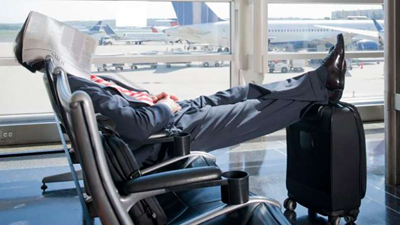Jerusalem, Oct 21: Reducing oxygen levels in an aeroplane cabin may help combat jet lag in travellers, suggests a new study which found that variation in oxygen levels can reset circadian clocks of mice and help them adapt eating, sleeping and running habits to the new time faster.
 Presently, light, food and temperature are the best known cues that can influence circadian rhythms.
Presently, light, food and temperature are the best known cues that can influence circadian rhythms.
Lead author Gad Asher, scientist at the Weizmann Institute of Science in Israel, and his colleagues studied that changing the concentration of oxygen in cells by just 3 per cent, twice a day, will synchronise mouse cells to a circadian rhythm.
They suspected protein HIF1a was the link between oxygen and the circadian clock because HIF1a plays both a role in oxygen homeostasis in cells.
They found that cells with low HIF1a levels will not synchronise in response to oxygen variations.
"It was extremely exciting to see that even small changes in oxygen levels were sufficient to efficiently reset the circadian clock," said Asher.
Researchers further explored oxygen's effect on circadian rhythms with jetlag experiments. Just like humans, mice are prone to jetlag after a sudden shift in daylight hours.
Mice were first left to eat, sleep and run on their wheels in air-controlled environments.
Altering oxygen levels alone did not change their circadian rhythms but once mice experienced a six-hour jump ahead in daylight hours, varying oxygen levels could help them adapt their eating, sleeping and running habits to the new time faster.
They also saw that a small drop in oxygen levels 12 hours before the six-hour daylight shift, or two hours afterwards, put the mice back on their circadian schedules faster and this too was dependent on HIF1a levels.
Presently, commercial airliners pressurise cabins to the same air density of a city 6,000-8,000 feet above sea level.
This low-pressure saves wear and tear on the airplane, but enough passengers suffer from airsickness in response to this drop in oxygen levels that some airlines are considering ways to increase the pressure on flights.
Researchers noted that passengers may feel better with higher pressurised cabins during flights, but may also lose a potential advantage of recovering from jetlag.
Understanding how oxygen influences the circadian clock goes beyond jetlag. Cardiovascular disease, COPD, shift work sleep disorder, and other common health problems can result in tissues with low oxygen levels.
"We show that oxygen works in mammals, specifically rodents, but it will be interesting to test whether oxygen can reset the clock of bacteria, plants, flies and additional organisms," said Asher.






Comments
Add new comment